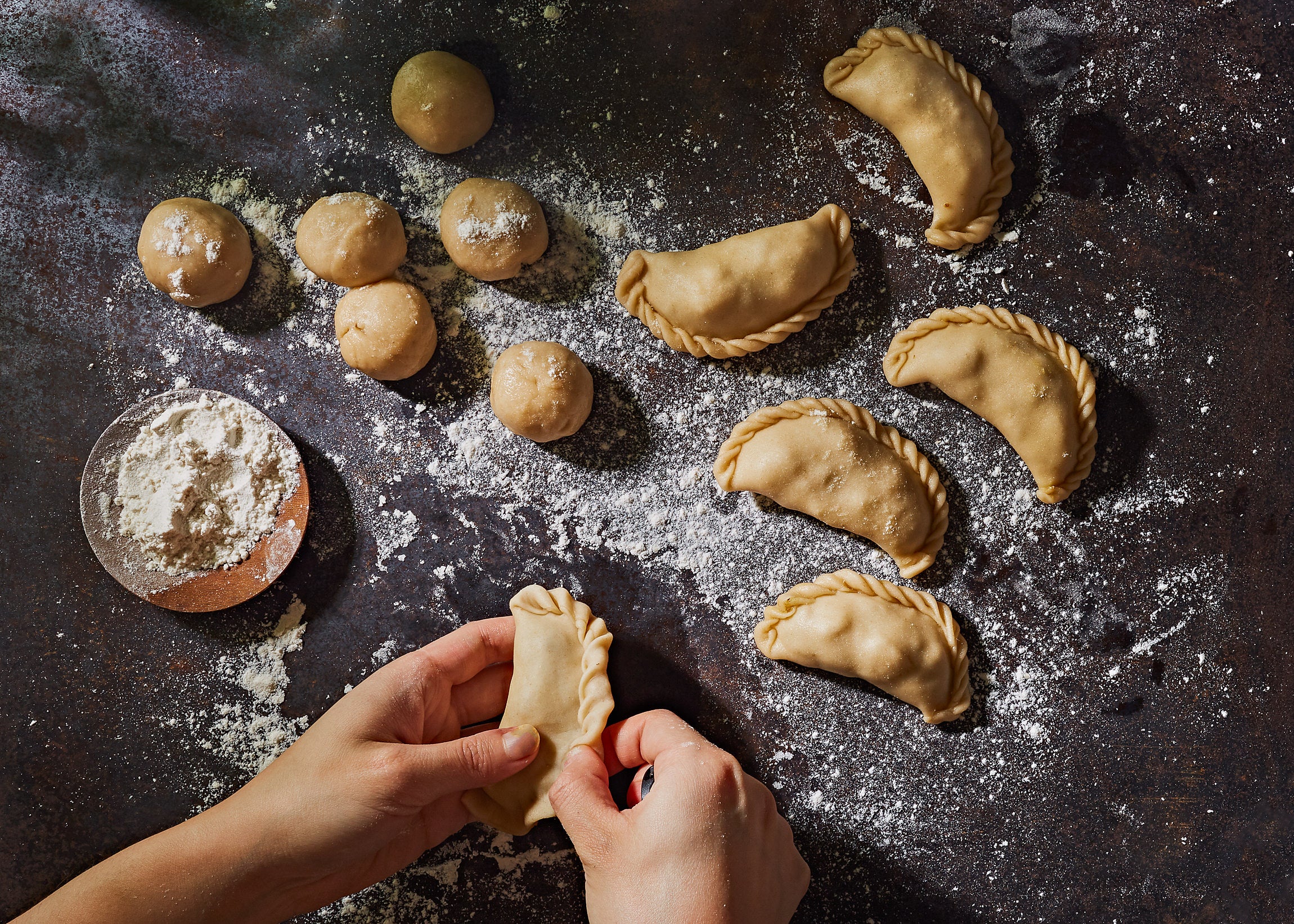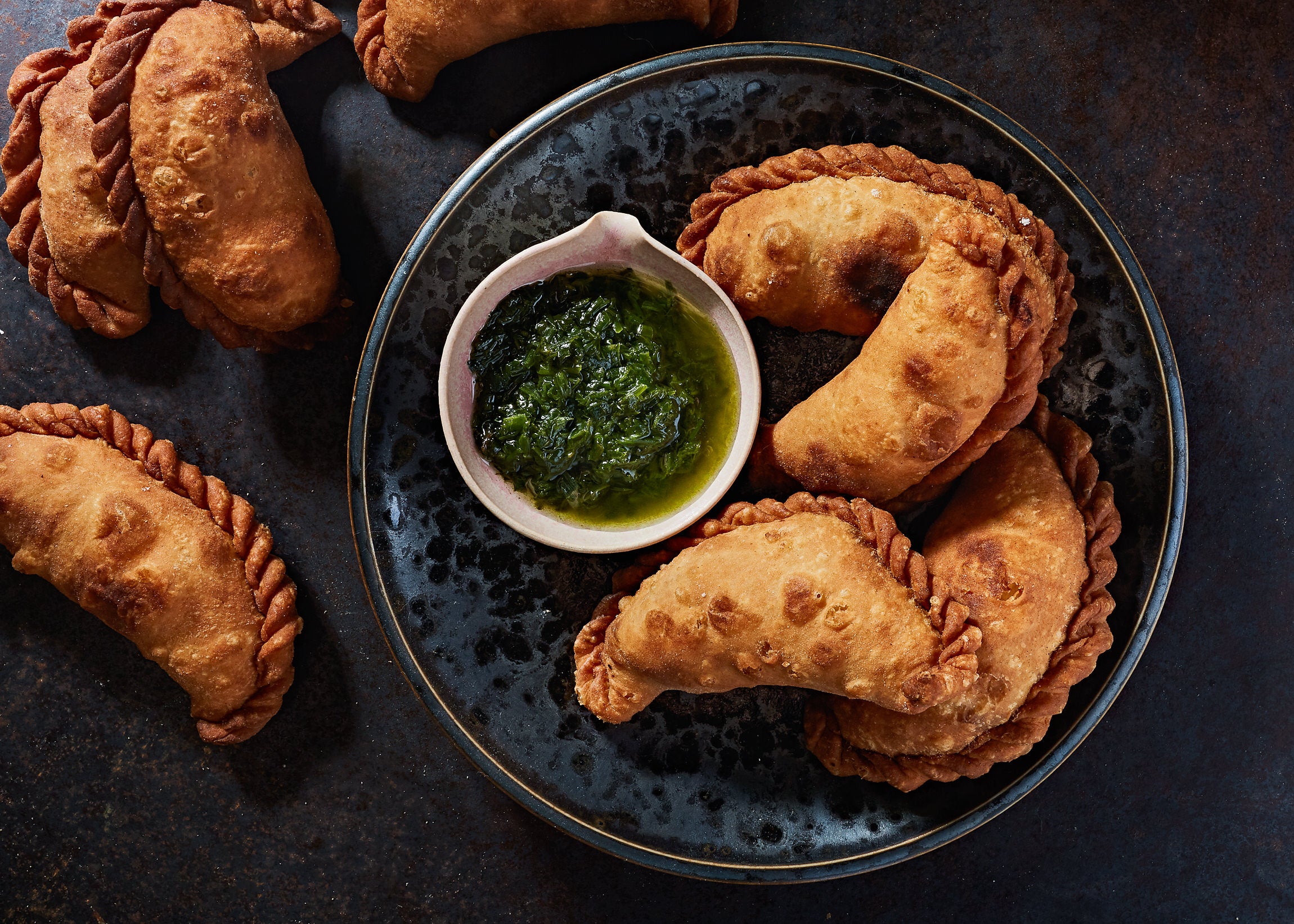Curry puffs, or epok epok, are fried savory pastries eaten throughout Malaysia and Singapore. They can also be a livelihood, a family tradition, and a gateway to friendship.
When I’m making curry puffs, I feel as though I’ve been transported to a busy kitchen in Singapore with my mom, grandma, aunts, and cousins. In my head, we’re side by side, laughing as my older cousins teach me how to roll dough and our nenek (grandma) and moms chop fresh ginger and onions. Even though my nenek passed away from Parkinson’s disease when I was four years old, I like to believe that by blasting Malay melodies by legends like P. Ramlee and Salmah Ismail, I’m summoning her spirit to join me as I cook.
Frying fresh curry leaves and mincing peeled knobs of ginger triggers childhood memories of my mom warning me to “Step back!” from the stovetop to avoid the flying sparks of hot oil. I remember watching her with intense focus as she poured golden melted ghee into a bowl of flour and water to make pastry dough. She rarely used measuring spoons or cups, but there was certainty and precision in her every move. When the dough was fully formed, she would hand me a chunk to replace the Play-Doh batch I was molding for practice.
Curry puffs, also known as epok epok in Malay, are a fried savory pastry similar to Cornish pasties, Indian samosas, or South American and Portuguese empanadas. While it’s hard to pinpoint the origin of Singapore’s signature street snack, historians believe epok epok might have been introduced in the 1800s to please the British colonizers’ taste for Cornish pasty. Others believe it was inspired by the Portuguese empanada and brought to the Malay Peninsula in the 1500s, when Portugal colonized and occupied Malacca. The early iteration of the curry puff had a short-crust pastry with a light, flaky skin similar to Western hand pies. The shape was said to have been changed by Muslim Malays to look like a crescent, a symbol of Islam.
Later on, around the 1970s, roving hawkers traveled to different neighborhoods, selling the curry puffs from mounted cases or baskets fastened to bicycles, tricycles, wheelbarrows, and carts. Still others carried their curry puffs in baskets attached to a shoulder yoke, or in trays balanced on their heads. Today, thanks to generations of Malaysian and Singaporean home cooks and hawkers, the pastries have transcended their colonial past.

Curry puffs can be filled with sardines, black-pepper chicken, ground beef, sweet potatoes, and even grass jelly (an Asian dessert) or durian, and for most Singaporeans they express a family’s culinary and cultural identity. The Malay-style epok epok, for example, is usually deep-fried with a thin, crunchy crust and filled with spicy curried potatoes, chicken, ground beef, or canned sardines. The Chinese rendition has a thick crust and a hard-boiled egg inside. Kali pap, meanwhile, is the Indian baked triangular or rectangular version. Singaporean cuisine is known for representing the country’s multiculturalism in almost every dish, which means you’ll often find curry puffs fused with Malay, Indian, and Chinese flavors and styles.
If I were in Singapore today, I’d make my way to the Geylang neighborhood to the pasar malam, or night market, to purchase at least a dozen epok epok loaded with cumin, curry powder, tomato-soaked tinned sardines, and thinly sliced red chilies.
At one point during my first pregnancy, my mom made me a batch of curry puffs. I remember scarfing down seven of them—each about the size of a small avocado—in under 10 minutes. I’ve realized that preparing and eating her curry puffs links me back to my mom’s childhood. She grew up in pre-urbanized Singapore with four brothers and two sisters in a kampong, or Malay village. Her family lived in an attap house, a palm-thatched dwelling built on hard dirt and lacking electricity and access to gas and running water. Living in poverty meant my mom and her family had to be resourceful with their food. But like most Malay home cooks, their frugality never compromised their keen ability to create mouthwatering meals and bring together large groups of people.
Because meat and poultry were too expensive, my nenek only prepared beef dishes like rendang (a slow-cooked dry curry dish sweetened with fresh coconut) on Eid al-Fitr, the holiday that marks the end of Ramadan. The curry puffs my mom diligently watched her prepare were meatless and instead filled with potato.
At 11, my mom stole dough from her mom to practice making her own curry puffs. Sometimes she sold my nenek’s epok epok and goreng pisang (fried bananas) to make money. Armed with stones to protect herself and her valuable basket of fried goods from stray dogs, she trekked from the kampong to wealthier neighborhoods. For those living in kampongs, she charged five cents for an epok epok, but for those living in well-off areas, the price spiked to 25 or 50 cents. (Respect the hustle.)

Recently, while I was making curry puffs for my Harlem housewarming party, I was taken back to my own childhood. As I pinched and folded the corners of the uncooked pastry to neatly crimp and enclose its contents, my six-year-old daughter begged me for some dough. I said no, mainly because I needed leftovers for my own mess-ups. Seconds later, my daughter perked up. “I’ll use my Play-Doh!” she declared, running into her room. I smiled as I watched her fingers mimic mine. After I ran out of the meat-and-potato filling, I handed my daughter a chunk of the dough, just as my mom had done for me 20 years earlier.
Curry puffs are also tied intricately to my mom’s experience as an immigrant. In 1999, when we moved to Alpine, a West Texas town of 5,000, my mom longed for ingredients like masala curry powder and ghee. There were two grocery stores, and neither carried her beloved staples, so my cousins sent packages from Singapore stuffed with bags of curry powder. More rations would come whenever my dad, who was at the time working on oil rigs in Indonesia, stopped in Singapore to visit my extended family and picked up packets of curry leaves for my mom before heading back to Texas.
For my mother, who felt isolated in Texas, curry puffs were a way to express friendship. Almost every week, she invited neighbors and close friends to come over and pick up freshly fried batches. None of them had ever tasted anything like it, and soon my mother was getting phone calls from friends of friends who wanted to buy them from her by the dozen. For others around town, the curry puffs reminded them of empanadas, and they too wanted more. People at school teased my brother and me for smelling like curry puffs, but of course they never shied away from asking for one (or a few) when my mom brought them to us for lunch. For the past 20 years, my mom’s curry puffs have brought the community together at birthday parties, funerals, graduations, weddings, and baby showers. “Have you tried Rosni’s curry puffs?” I’d hear someone ask at a quinceañera. “You have to try them!”
And when the locals of this West Texas desert town ask her for a recipe, my mom shrugs and says, “I don’t have one. Just come watch me make it.”